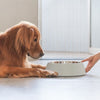Is My Dog Drinking Enough Water?
- by Rufus and Coco
Making sure that your canine friend gets plenty of water should be a concern of any responsible pet parent. In dogs and cats, dehydration can be extremely dangerous and, in some cases, it can even put your pet’s health and life at risk.
In today’s article, we’re looking at several ways of telling if your dog is getting enough water and a couple of tips on how you can convince your dog to drink more.
Is my dog drinking enough water?
Water is a critical ingredient as it allows your dog’s body to function properly and it’s also involved in a number of internal processes from aiding digestion to lubricating your pet’s joints.
Dehydration doesn’t occur extremely fast unless your pet is suffering from a condition that causes incessant vomiting and diarrhea. In this case, your pooch will lose fluids a lot faster than a dog that has spent some time under the sun, for example.
The main signs of dehydration in dogs are the following:
- Panting
- Dry mucous membranes (dry nose, dry gums)
- A thicker consistency of your pet’s saliva
- Decreased skin elasticity

One thing that we have to note is that dogs usually drink enough water so that their bodies can function normally. Sometimes, they can even drink too much, especially after they have engaged in a particularly strenuous activity on a hot day.
Dehydration can occur due to disease, a lack of appetite in food and water in general, or as a result of no access to water.
How to tell if your dog is drinking enough water
Scruff test
A scruff test is the easiest way to tell if your dog is drinking enough water or not. You can simply hold some of your dog’s skin up (the one between their shoulder blades) and see how long it takes for it to get back in its normal position.
In dogs that aren’t dehydrated, the skin will spring back to its original position in less than 1 or 2 seconds (maximum). In dehydrated dogs, on the other hand, it will take some time for it to get back to normal -- over the 3-second mark.
Capillary refill time
Since water is an essential ingredient in your dog’s circulatory system and it effectively ensures that blood comes and goes from one organ to another, another test you can perform is the capillary refill time.
As previously mentioned, the nose and gums of dehydrated animals are dry. But dryness is not the only symptom you should base your verdict on. If your dog has light pink or pink gums, you can press your finger on them and wait to see what happens.
In dogs that are not dehydrated, the pinkish colour will return to the area you’ve pressed on in less than one or two seconds. The same rule does not apply for dogs that are dehydrated -- it’ll take longer for the area to become pink again.
Thirst
It goes without saying that a dog that hasn’t had enough water to drink is going to be thirsty, so they will also be restless -- they’ll look at their water bowl, then back at you and try to tell you that they need water now.
Loss of appetite
A dehydrated dog or one that’s just not drinking enough water is not going to be as enthusiastic about food or even treats.
Sometimes, dogs can suffer from constipation just as people, and it is often a result of a lack of appetite for water. A constipated, dehydrated dog is not going to want to put any more pressure on their digestive system by eating more food.
Lethargy
A dehydrated dog is not exactly full of energy. If you know your pooch’s character, and chances are that you do, you can probably tell when something is wrong and when they are being unusually quiet or calm.
If the water bowl is untouched and your dog has been lying still on the couch for a couple of hours, it wouldn’t hurt for you to take them to the vet clinic for a check-up.

How to get a dog to drink more water
While dogs aren’t nearly as demanding as cats when it comes to water, they still like it to be fresh and clean. If you do not replace your pooch’s water every day, they’re probably not going to want to drink it.
It would be even better if you could replace it twice a day - once in the morning and once in the evening. Getting a pet fountain could be a good idea if you want to make sure that your dog is getting enough water throughout the day and also doesn’t drink too much all of a sudden.
Warm water is less appealing to dogs, so make sure that your dog’s water bowl is always in the shade. Finally, some dogs aren’t going to drink it if it contains rocks, dirt, or hair, or anything else that might make it dirty.
Some dogs also don’t like the plain taste of tap water, especially if your local authorities are using chlorine to disinfect and make it potable. In this case, you can give your dog tea, instead, or a nice bone broth. Nothing beats a bone broth in the winter, and it also contains collagen, which is great for your dog’s joints.
Another way of making sure that your dog is indirectly getting some water is to use veggies and/or fruits as treats. Cucumbers are great as their water content is high as well as watermelon, which most dogs love.

Keeping your dog hydrated on the go
If you’re planning a hike with your canine buddy and you know that you’re going to spend three to four hours outdoors, you have to bring some water with you.
But then there’s the issue that dogs can’t drink like humans can, meaning you’re going to need a portable water bowl. Collapsible models are excellent in this case, and they don’t even take up a lot of room in your backpack.
How much water does my dog need?
You can’t compare a Chihuahua’s water needs to those of a Newfoundland, right? So there should be a golden rule for all dog sizes.
Ideally, your dog should get 1 ounce of water per 1 pound of their body weight.
Avoid giving your dog too much water at once
If your pooch is thirsty and panting, it can be very tempting to give them a lot of water right away. Unfortunately, dogs can develop something called bloat (also known as volvulus), a condition where their stomach rotates around its own axis due to a large amount of liquid or food having been ingested.
Bloat can be life-threatening and is more common in larger breeds. Give your dog small and frequent sips and take a short 5 to 10-minute break, no matter how much your dog might want to drink after having played or exercised under the sun. When this happens, keep your dog in the shade until they at least stop panting and then continue giving them small sips until they’ve had enough.
- Posted in:
- dog
- health-tips
- how to help





